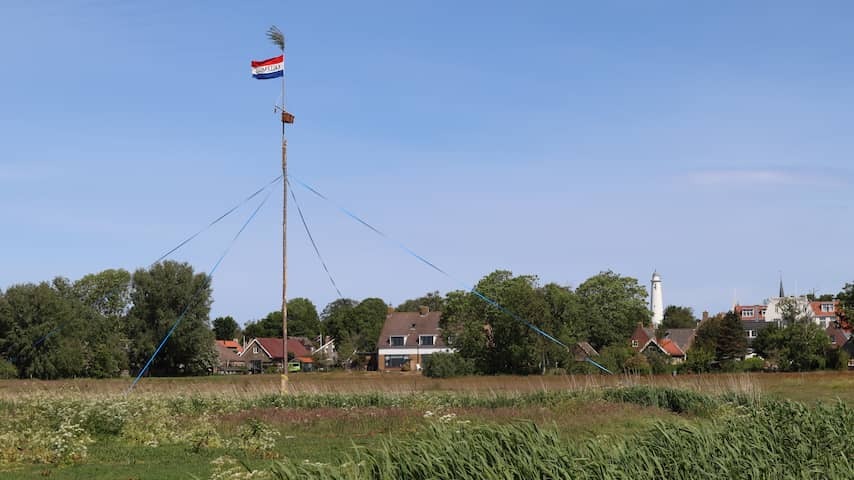
The centuries-old folk festival Kallemooi on Schiermonnikoog is causing discussion because animal organizations want to stop the confinement of a rooster during the festival. Despite adjustments and lawsuits, the Ministry of Agriculture considers the tradition more important than the objections of animal organizations for the time being.
Why is this important?
1. What is Kallemooi?
Every year during Pentecost, it is time for the traditional Kallemooi festival on Schiermonnikoog. On Saturday around midnight, villagers together erect a more than 20-meter-high mast, a special moment in the festival. The mast remains upright for three days, firmly tied with thick ropes.
High in the mast hangs a crossbar with a gin jug on both sides. Just below it hangs a large basket. In the basket is a live rooster with enough food and water. On top of the mast, a green branch and a red-white-blue flag are hoisted with the text “Kallemooi”.
As soon as the mast is erected, the festival erupts with music, dance, and stories. On the Tuesday after Pentecost, Whit Tuesday, there are children’s games and a parade with decorated floats through the village. At the end of the festival, the basket with the rooster is carefully lowered, and the animal is released again.
Kallemooi is one of the oldest festivals in the Netherlands. The oldest mention dates back to 1646, but the festival is probably much older. Similar rooster-in-the-mast festivals used to occur in more places in the Netherlands, but now only on Schiermonnikoog.
2. Why is there so much concern about the Kallemooi rooster now?
Animal rights organizations state that the rooster suffers unnecessarily for three days in the basket at the top of the mast. They call this “serious and without reasonable purpose”. “We have filed a report and submitted an enforcement request, but authorities keep passing the buck to each other. We just want a clear statement and that the law is complied with,” says Sandra van de Werd of Comité Dierennoodhulp to NU.nl.
“Adjustments have already been made to the festival,” says Van de Werd. “In the past, the rooster was lifted by its wings and carried around, now nobody actually sees him anymore. Then rather opt for a digital rooster.”
Professor of Animal Welfare Bas Rodenburg emphasizes that the welfare of the rooster is indeed at stake. “Especially because he is socially isolated. Chickens and roosters are social animals. Three days alone in a basket is very stressful for such an animal.”
Opponents of adjustments point to the importance of tradition. According to the Ministry of Agriculture, Fisheries, Food Security, and Nature, the discomfort of the rooster is “minor” and the cultural heritage weighs heavier. After the event, the rooster is released again. Mayor Ineke van Gent of Schiermonnikoog states that a rooster in bio-industry has it worse.
The Administrative Jurisdiction Division of the Council of State previously found that the objections of animal organizations should be better investigated. Therefore, State Secretary Jean Rummenie (Agriculture) had to look again at whether the confinement of the ‘Kallemooi rooster’ is against the rules.
“According to the law, you may not cause animals pain or stress without good reason. In this case, it is animal abuse because the welfare of the rooster is unnecessarily harmed,” says Professor Rodenburg.
Animal organizations often propose replacing the live rooster, but on Schiermonnikoog people strongly adhere to the old custom. For many islanders, the rooster belongs to Kallemooi and the festival symbolizes the identity and solidarity of the village.
The chairman of the Kallemooi Committee does not want to talk to the press. “We do not give interviews,” he says.
3. Why is a rooster needed for the festival?
The rooster is considered a symbol of fertility and vigilance. The mast refers to the maypole. Both are part of a pagan spring tradition with roots in Germanic and Scandinavian festivals. The mast is always between the church and an inn, also according to ancient custom.
According to some, ‘Kallemooi’ refers to the Old Norse word for ‘calling May’. Others think it comes from ‘gallus’ (rooster).
4. What happens next?
Animal organizations have been trying for years to prevent a live rooster from being put in the basket any longer, but they have not succeeded. They hope that the ministry will still intervene. But according to the State Secretary, the welfare of the rooster is barely affected and it is important that the tradition continues.
According to a spokesperson, the Netherlands Enterprise Agency recently reviewed the objection of the animal organizations and expert declarations. She says that the outcome is the same as before. The State Secretary is therefore still not taking any steps.
After years of legal wrangling, additional measures have been taken for the welfare of the animal. For example, a veterinarian keeps a close eye on the rooster via a camera.